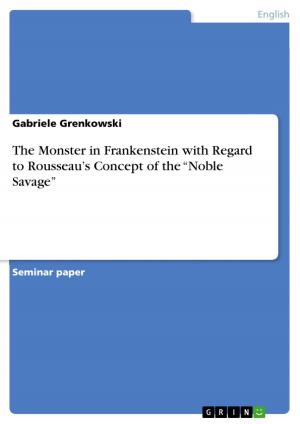Identity in Zadie Smith's 'White Teeth' and Hanif Kureishi's 'My Beautiful Laundrette'
Fiction & Literature, Literary Theory & Criticism, British| Author: | Elisabeth Werdermann | ISBN: | 9783640922628 |
| Publisher: | GRIN Verlag | Publication: | May 23, 2011 |
| Imprint: | GRIN Verlag | Language: | English |
| Author: | Elisabeth Werdermann |
| ISBN: | 9783640922628 |
| Publisher: | GRIN Verlag |
| Publication: | May 23, 2011 |
| Imprint: | GRIN Verlag |
| Language: | English |
Bachelor Thesis from the year 2011 in the subject English Language and Literature Studies - Literature, grade: 1,3, University of Paderborn (Institut für Kulturwissenschaften), language: English, abstract: Who am I? What makes me me? These are questions of daily importance to every individual human being. The question of what defines us in our per-sonality cannot be answered in a single sentence, or easily. Multiple external factors from the field of culture such as ethnicity, race, class, gender, sexual orientation or history impinge on who we are, what we identify ourselves or are identified with. According to the Oxford English Dictionary, identity defines 'Who or what a person or thing is; a distinct impression of a single person or thing presented to or perceived by others; a set of char-acteristics or a description that distinguishes a person from others.' Depending on a person's social surroundings with all its cultural identifiers, his or her identity is shaped. In Zadie Smith's novel White Teeth and Hanif Kureishi's screenplay My Beautiful Laundrette identity is presented and problematised as 'In-betweenness' . Both works focus on immigrants and their children, the se-cond generation, and the difficulties they face in their daily life caused by in-betweenness. In-betweenness as a term is quite self-explanatory and depicts ambiguity on several levels like belonging, ethnicity or sexual orientation/ habits, to name only a few. This ambiguity entails the social life of the characters as well as their emotional state. In the context of belonging, it is Cherry, from My Beautiful Laundrette, who first brings the term 'in-betweenness' up: Oh God, I'm so sick of hearing about these in-betweens. People should make up their minds where they are. (Kureishi, p. 37) By this, she labels the subliminal topic of both literary works. With In-betweenness as a special form of identity, this research paper searches for reasons and circumstances, which make the characters in White Teeth and My Beautiful Laundrette feel in-between. On the basis of their behaviour and emotional condition against the background of their cul-tural affiliations, it will also specify the conflicts and probable advantages the state of in-betweenness entails.
Bachelor Thesis from the year 2011 in the subject English Language and Literature Studies - Literature, grade: 1,3, University of Paderborn (Institut für Kulturwissenschaften), language: English, abstract: Who am I? What makes me me? These are questions of daily importance to every individual human being. The question of what defines us in our per-sonality cannot be answered in a single sentence, or easily. Multiple external factors from the field of culture such as ethnicity, race, class, gender, sexual orientation or history impinge on who we are, what we identify ourselves or are identified with. According to the Oxford English Dictionary, identity defines 'Who or what a person or thing is; a distinct impression of a single person or thing presented to or perceived by others; a set of char-acteristics or a description that distinguishes a person from others.' Depending on a person's social surroundings with all its cultural identifiers, his or her identity is shaped. In Zadie Smith's novel White Teeth and Hanif Kureishi's screenplay My Beautiful Laundrette identity is presented and problematised as 'In-betweenness' . Both works focus on immigrants and their children, the se-cond generation, and the difficulties they face in their daily life caused by in-betweenness. In-betweenness as a term is quite self-explanatory and depicts ambiguity on several levels like belonging, ethnicity or sexual orientation/ habits, to name only a few. This ambiguity entails the social life of the characters as well as their emotional state. In the context of belonging, it is Cherry, from My Beautiful Laundrette, who first brings the term 'in-betweenness' up: Oh God, I'm so sick of hearing about these in-betweens. People should make up their minds where they are. (Kureishi, p. 37) By this, she labels the subliminal topic of both literary works. With In-betweenness as a special form of identity, this research paper searches for reasons and circumstances, which make the characters in White Teeth and My Beautiful Laundrette feel in-between. On the basis of their behaviour and emotional condition against the background of their cul-tural affiliations, it will also specify the conflicts and probable advantages the state of in-betweenness entails.















